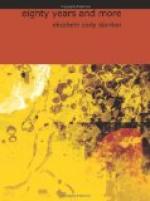It was a bright, cool day on which we took the train for Toulouse, and we enjoyed the delightful run through the very heart of old Gascony and Languedoc. It was evident that we were in the South, where the sun is strong, for, although summer had scarcely begun, the country already wore a brown hue. But the narrow strips of growing grain, the acres of grape vines, looking like young currant bushes, and the fig trees scattered here and there, looked odd to the eye of a native of New York.
We passed many historical spots during that afternoon journey up the valley of the Garonne. At Portets are the ruins of the Chateau of Langoiran, built before America was discovered, and, a few miles farther on, we came to the region of the famous wines of Sauterne and Chateau-Yquem. Saint Macaire is a very ancient Gallo-Roman town, where they show one churches, walls, and houses built fifteen centuries ago. One of the largest towns has a history typical of this part of France, where wars of religion and conquest were once the order of the day. It was taken and retaken by the Goths, Huns, Burgundians, and Saracens, nobody knows how many times, and belonged, successively, to the kings of France, to the dukes of Aquitaine, to the kings of England, and to the counts of Toulouse. I sometimes wonder whether the inhabitants of our American towns, whose growth and development have been free and untrammeled as that of a favorite child, appreciate the blessings that have been theirs. How true the lines of Goethe: “America, thou art much happier than our old continent; thou hast no castles in ruins, no fortresses; no useless remembrances, no vain enemies will interrupt the inward workings of thy life!”
We passed through Moissac, with its celebrated organ, a gift of Mazarin; through Castle Sarrazin, founded by the Saracens in the eighth century; through Montauban, that stronghold of the early Protestants, which suffered martyrdom for its religious faith; through Grisolles, built on a Roman highway, and, at last, in the dusk of the evening, we reached “the Capital of the South,” that city of learning—curious, interesting old Toulouse.
Laura Curtis Bullard, in her sketch of me in “Our Famous Women,” says: “In 1882, Mrs. Stanton went to France, on a visit to her son Theodore, and spent three months at the convent of La Sagesse, in the city of Toulouse.” This is quite true; but I have sometimes tried to guess what her readers thought I was doing for three months in a convent. Weary of the trials and tribulations of this world, had I gone there to prepare in solitude for the next? Had I taken the veil in my old age? Or, like high-church Anglicans and Roman Catholics, had I made this my retreat? Not at all. My daughter wished to study French advantageously, my son lived in the mountains hard by, and the garden of La Sagesse, with its big trees, clean gravel paths, and cool shade, was the most delightful spot.




